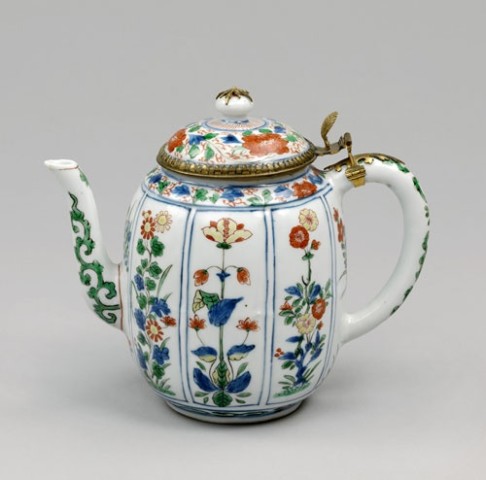Of flattened ovoid form with "C" shaped handle, curved spout and low domed cover with knop finial, the body decorated in the Kakiemon palette with sprays of flowers, the eight-lobed melon form body enamelled in close imitation of Japanese Kakiemon style ware, each panel framed in blue, depicting various flowering plants; flower-scroll borders encircle the shoulder and lid and lotus-gold foliage decorates the spout and handle, European copper mounts on the lid.
Literature
For discussion of an almost identical object, see Porcelain for Palaces: The Fashion for Japan in Europe 1650 - 1750 (John Ayers, Oliver Impey, J.V.G. Mallet), Oriental Ceramic Society, 1990, plate 252 page 234, for a near identical example in the collection of Her Majesty the Queen, collection number RCIN 58833.
Dr. Impey writes, "There are very few examples of direct Chinese copying of Kakiemon-style wares. A matching Japanese teapot from the Jenyns collection is displayed in the Fitzwilliam Museum, Cambridge; s. Jenyns, 1965, Plate 78A, also Pl. 78B for another Chinese speciamen. Both were no doubt made to meet a Western demand, for Japanese tea-making procedures did not require such a pot. As Jenyns argues (p. 33), the Chinese version will have been supplied to the Dutch in Batavia, if not to European traders at other entrepots."
See also SoameJenyns Japanese Porcelain, published Faber & Faber 1965 p.153 in which he writes: "There are also Chinese tea pots decorated with poppies in panels in coloured enamels which are exact reproductions of Kakiemon tea pots, except that underglaze blue is used instead of blue enamel, but these are rare (Pl 78B)."
Even in a catalogue full of rarities as is Porcelain for Palaces Impey points out that there were few examples of direct copying in this way and in a socio-historical context this makes the teapot even more interesting. The Fitzwilliam model bequeathed by Soame Jenyns is also almost identical to our model.

